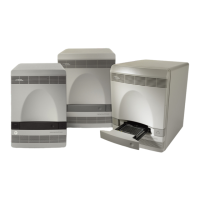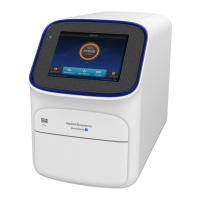DRAFT
September 25, 2007 1:07 am, 4376782_Glossary.fm
Glossary
Applied Biosystems StepOne
™
and StepOnePlus
™
Real-Time PCR Systems
Installation, Networking, and Maintenance Guide
CONFIDENTIAL — For AB Internal Use Only. Do Not Distribute.
140
cycling stage In the thermal profile, a stage that is repeated. A cycling stage is also called an
amplification stage. For cycling stages, you can enable AutoDelta settings. See also
amplification stage.
data collection A process during the instrument run in which an instrument component detects
fluorescence data from each well of the reaction plate. The instrument transforms the
signal to electronic data, and the data are saved in the experiment file. In the StepOne
™
software, a data collection point is indicated by an icon in the thermal profile:
• Data collection on:
• Data collection off:
delta Rn (
∆Rn) See baseline-corrected normalized reporter (∆Rn).
derivative reporter
(−Rn′ )
The negative first-derivative of the normalized fluorescence generated by the reporter
during PCR amplification. In the derivative reporter (–Rn′ ) vs. temperature melt curve,
the derivative reporter signal is displayed in the y-axis.
Design Wizard A feature in the StepOne
™
software that helps you set up your experiment by guiding you
through best practices as you enter your experiment design.
diluent A reagent used to dilute a sample or standard before adding it to the PCR reaction. The
diluent can be water or buffer.
Diluted Sample
Concentration
(10✕ for Reaction
Mix)
In the StepOne
™
software, a field displayed on the Sample Dilution Calculations tab of
the Reaction Setup screen. For this field, enter the sample concentration you want to use
to add to the reaction mix for all samples in the experiment. “10✕ for Reaction Mix”
indicates that the software assumes the sample or standard component of the reaction mix
is at a 10✕ concentration. For example, if the diluted sample concentration is 50.0 ng/µL
(10✕), the final sample concentration in the reaction is 5 ng/µL (1✕).
dilution factor See serial factor.
dissociation curve See melt curve.
EFF% See amplification efficiency (EFF%).
endogenous
control
A target or gene that should be expressed at similar levels in all samples you are testing.
Endogenous controls are used in relative standard curve and comparative C
T
(∆∆C
T
)
experiments to normalize fluorescence signals for the target you are quantifying.
Housekeeping genes can be used as endogenous controls. See also housekeeping gene.
endpoint read See post-PCR read.
